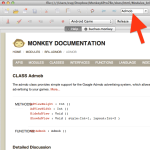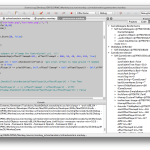Strict
Import mojo
Global game:MyGame
Function Main:Int()
game = New MyGame
Return 0
End Function
Const PDM_smlparticle%=0
Const PDM_medparticle%=1
Const PDM_bigparticle%=2
Const PDM_spark%=3
Global ASTEROIDS_NUM% = 6
Global ASTEROIDS_SIZE% = 4
' Store the device width and height
Global SCREEN_WIDTH%
Global SCREEN_HEIGHT%
' Half of SCREEN_WIDTH and HEIGHT
Global SCREEN_WIDTH2%
Global SCREEN_HEIGHT2%
' Used for delta timing movement
Global dt:DeltaTimer
' Screen states
Const STATE_TITLE% = 1
Const STATE_GAME% = 2
Const STATE_GAME_OVER% = 3
Class MyGame Extends App
Field player:Player
Field cg%, cr%, cb%
Field level% = 1
Field score% = 0
Field bestScore% = 0
Field FPS% = 60
' Current game state
Global gameState:Int = STATE_TITLE
Method OnCreate:Int()
' Store the device width and height
SCREEN_WIDTH = DeviceWidth()
SCREEN_HEIGHT = DeviceHeight()
SCREEN_WIDTH2 = SCREEN_WIDTH / 2
SCREEN_HEIGHT2 = SCREEN_HEIGHT / 2
' Set the Random seed
Seed = Millisecs()
' Create the delta timer
dt = New DeltaTimer(FPS)
SetUpdateRate FPS
reset()
Return 0
End Method
Method OnLoading:Int()
Cls 0,0,0
DrawText("Loading", SCREEN_WIDTH2, SCREEN_HEIGHT2, 0.5, 0)
Return 0
End Method
Method OnUpdate:Int()
FPSCounter.update()
dt.UpdateDelta()
Select gameState
Case STATE_TITLE
Asteroid.updateAll()
If KeyHit(KEY_SPACE)
setState(STATE_GAME)
Endif
Case STATE_GAME
player.Update()
Bullet.updateAll()
Asteroid.updateAll()
Particle.updateAll()
checkCollisions()
clscolor()
Case STATE_GAME_OVER
Asteroid.updateAll()
Particle.updateAll()
If KeyHit(KEY_SPACE)
setState(STATE_TITLE)
reset()
Endif
End Select
Return 0
End Method
Method OnRender:Int()
Select gameState
Case STATE_TITLE
Cls 0, 0, 0
Asteroid.drawAll()
DrawText ("ASTEROIDS - MONKEY STYLE!", SCREEN_WIDTH2, SCREEN_HEIGHT2, 0.5, 0.5)
DrawText ("BEST SCORE: "+Self.bestScore, SCREEN_WIDTH2, SCREEN_HEIGHT2 + 30, 0.5, 0.5)
DrawText ("PRESS <space> TO PLAY", SCREEN_WIDTH2, SCREEN_HEIGHT2 + 60, 0.5, 0.5)
Case STATE_GAME
Cls cr, cg, cb
player.draw()
Bullet.drawAll()
Asteroid.drawAll()
Particle.drawAll()
drawHUD()
Case STATE_GAME_OVER
Cls 0, 0, 0
Asteroid.drawAll()
Particle.drawAll()
DrawText ("GAME OVER!", SCREEN_WIDTH2, SCREEN_HEIGHT2, 0.5, 0.5)
DrawText ("SCORE: "+score, SCREEN_WIDTH2, SCREEN_HEIGHT2 + 30, 0.5, 0.5)
DrawText ("BEST SCORE: "+Self.bestScore, SCREEN_WIDTH2, SCREEN_HEIGHT2 + 60, 0.5, 0.5)
DrawText ("PRESS <space> TO RETURN TO THE TITLE SCREEN", SCREEN_WIDTH2, SCREEN_HEIGHT2 + 90, 0.5, 0.5)
End Select
Return 0
End Method
Method setState:Void(state:Int)
gameState = state
End
Method clscolor:Void()
If cr > 0
cr-=2*dt.delta
Else
cr = 0
Endif
End Method
Method reset:Void()
Bullet.list.Clear()
Asteroid.list.Clear()
Particle.list.Clear()
cg = 0
cr = 0
cb = 0
level = 1
ASTEROIDS_NUM = 6
ASTEROIDS_SIZE = 4
score = 0
player = New Player(SCREEN_WIDTH2, SCREEN_HEIGHT2)
fillAsteroids(ASTEROIDS_NUM, ASTEROIDS_SIZE)
End Method
Method checkCollisions:Void()
For Local a:Asteroid = Eachin Asteroid.list
If dist(player.x, player.y, a.x, a.y) <= a.avgrad
If cr = 0 Then cr = Rnd(100, 155)
player.shield-=2
Endif
For Local b:Bullet = Eachin Bullet.list
If a <> Null Then
If dist(b.x, b.y, a.x, a.y) <= a.avgrad
a.life = a.life - 1
b.life = 0
For Local t%=1 To 4
New Particle(a.x, a.y, Rnd(-8,8), Rnd(-8,8), 0.95, 30, PDM_spark, 255, 192, 64, 16)
Next
For Local t%=1 To 4
New Particle(a.x, a.y, Rnd(-4,4), Rnd(-4,4), 0.95, 60, PDM_smlparticle, 160, 160, 160, 0)
Next
Endif
If a.life <= 0
For Local t%=1 To 8
New Particle(a.x,a.y,Rnd(-10,10),Rnd(-10,10),0.95,30,PDM_spark,255,192,64,64)
Next
For Local t%=1 To 6
New Particle(a.x,a.y,Rnd(-6,6),Rnd(-6,6),0.95,30,PDM_medparticle,255,192,64,128)
Next
For Local t%=1 To 6
New Particle(a.x,a.y,Rnd(-8,8),Rnd(-8,8),0.99,60,PDM_smlparticle,160,160,160,0)
Next
For Local t%=1 To 5
New Particle(a.x,a.y,Rnd(-6,6),Rnd(-6,6),0.99,60,PDM_medparticle,160,160,160,0)
Next
For Local t%=1 To 4
New Particle(a.x,a.y,Rnd(-4,4),Rnd(-4,4),0.99,60,PDM_bigparticle,160,160,160,0)
Next
If a.size > 1
For Local t% = 1 To 2
New Asteroid(a.x, a.y, Rnd(-5,5), Rnd(-5,5), a.size-1)
Next
Endif
Asteroid.list.Remove(a)
a = Null
score+=5
Endif
Endif
Next
Next
If Asteroid.list.Count() = 0
level+=1
ASTEROIDS_SIZE+=1
ASTEROIDS_NUM+=1
fillAsteroids(ASTEROIDS_NUM, ASTEROIDS_SIZE)
Endif
End Method
Method drawHUD:Void()
DrawText ("LEVEL: "+level, 0, 0)
DrawText("SCORE: "+score, SCREEN_WIDTH, 0, 1, 0)
FPSCounter.draw(SCREEN_WIDTH,SCREEN_HEIGHT, 1, 1)
End Method
Method fillAsteroids:Void(num%, size%)
Local tx#
Local ty#
For Local t% = 1 To num
Repeat
tx=Rnd(640)
ty=Rnd(480)
Until ( tx<280 or="" tx="">360 ) And ( ty<200 or="" ty="">280 )
New Asteroid(tx, ty, Rnd(-3,3), Rnd(-3,3), size+Rnd(1))
Next
End Method
End Class
Class Sprite
Field xv# ,yv#
Field x#, y#
Field rotation#
End Class
Class Player Extends Sprite
Field angVel#
Field velmul#
Field vel#
Field acc#
Field drag#
'Field xv#,yv#
Field xa#,ya#
Field firedel#
Field ship_angvel#
Field ship_acc#
Field ship_velmul#
Field ship_firedel#
Field shield#=100
Method New(x#, y#)
Self.x = x
Self.y = y
ship_angvel = 6
ship_acc = 0.16
ship_velmul = -0.0005
ship_firedel = 4
shield = 100
End Method
Method Update:Void()
If KeyDown(KEY_UP)
acc = ship_acc
drag = vel * ship_velmul
Else If KeyDown(KEY_DOWN)
drag = vel * ship_velmul * 50
Else
acc = 0
drag = 0
End If
If KeyDown(KEY_LEFT)
rotation+=ship_angvel * dt.delta
End If
If KeyDown(KEY_RIGHT)
rotation-=ship_angvel * dt.delta
End If
If KeyDown(KEY_SPACE) And Self.firedel<=0
Local tang#=Rnd(-4,4)
New Bullet(x - (Sin(rotation)*8), y-(Cos(rotation)*8), xv - (Sin(rotation + tang ) *12), yv-(Cos(rotation + tang ) *12), 45, 255-Rnd(4), 192+Rnd(-4,4), 64+Rnd(4,4))
firedel = ship_firedel
Endif
firedel-=dt.delta
xa = (drag * xv) - (Sin(rotation) * acc)
ya = (drag * yv) - (Cos(rotation) * acc)
xv = xv + xa *dt.delta
yv = yv + ya * dt.delta
x = x + xv * dt.delta
y = y + yv * dt.delta
vel = dist(0, 0, xv, yv)
'
If x < 0 x = SCREEN_WIDTH
If x > SCREEN_WIDTH x = 0
If y < 0 y = SCREEN_HEIGHT
If y > SCREEN_HEIGHT y = 0
If shield <= 0
For Local t%=1 To 18
New Particle( x, y,Rnd(-10,10),Rnd(-10,10),0.95,130,PDM_spark,255,192,64,64)
Next
For Local t%=1 To 16
New Particle( x, y,Rnd(-6,6),Rnd(-6,6),0.95,130,PDM_medparticle,255,192,64,128)
Next
For Local t%=1 To 16
New Particle( x, y,Rnd(-8,8),Rnd(-8,8),0.99,160,PDM_smlparticle,160,160,160,0)
Next
For Local t%=1 To 15
New Particle( x, y,Rnd(-6,6),Rnd(-6,6),0.99,160,PDM_medparticle,160,160,160,0)
Next
For Local t%=1 To 14
New Particle( x, y,Rnd(-4,4),Rnd(-4,4),0.99,160,PDM_bigparticle,160,160,160,0)
Next
If game.score>game.bestScore
game.bestScore = game.score
Endif
game.setState(STATE_GAME_OVER)
Endif
End Method
Method draw:Void()
Local x1# = x-(Sin(rotation) * 10)
Local y1# = y-(Cos(rotation) * 10)
Local x2# = x-(Sin(rotation + 140 ) * 8)
Local y2# = y-(Cos(rotation + 140 ) * 8)
Local x3# = x-(Sin(rotation - 140 ) * 8)
Local y3# = y-(Cos(rotation - 140 ) * 8)
SetColor 255, 255, 255
DrawLine x1, y1, x2, y2
DrawLine x2, y2, x3, y3
DrawLine x3, y3, x1, y1
SetAlpha 0.5
If shield < 50 Then SetColor 255,0,0
DrawRect 10,SCREEN_HEIGHT - 15, Self.shield, 10
SetAlpha 1
SetColor 255,0,0
End Method
End Class
Class Bullet Extends Sprite
Global list:List<bullet> = New List<bullet>
Field life#
Field cr%, cg%, cb%
Method New(x#,y#,xv#,yv#,life#,cr%,cg%,cb%)
Self.x = x
Self.y = y
Self.xv = xv
Self.yv = yv
Self.life = life
Self.cr = cr
Self.cg = cg
Self.cb = cb
list.AddLast Self
End Method
Function updateAll:Void()
If Not list Return
For Local b:Bullet = Eachin list
b.update()
If b.life < 0
Bullet.list.Remove(b)
b = Null
Endif
Next
End Function
Method update:Void()
x = x + xv * dt.delta
y = y + yv * dt.delta
life-=dt.delta
If x < 0 x = SCREEN_WIDTH
If x > SCREEN_WIDTH x = 0
If y < 0 y = SCREEN_HEIGHT
If y > SCREEN_HEIGHT y = 0
End Method
Function drawAll:Void()
If Not list Return
For Local b:Bullet = Eachin list
b.draw()
Next
End Function
Method draw:Void()
Local tmul#
If life <= 15.0
tmul = life / 15.0
Else
tmul = 1.0
Endif
SetColor cr*tmul, cg*tmul, cb*tmul
DrawLine x, y, x + xv, y + yv
End Method
End Class
Class Asteroid Extends Sprite
Global list:List<asteroid> = New List<asteroid>
Field ang#,angvel#
Field rad#[9]
Field avgrad#
Field size%
Field life%
Field cr%, cg%, cb%
Method New(x#,y#,xv#,yv#,size%)
Self.x =x
Self.y =y
Self.xv =xv
Self.yv =yv
Self.ang =Rnd(360)
Self.angvel =Rnd(-6,6)
Self.size=size
Self.life=size
Local tcol% = Rnd(-48,48)
Self.cr=128+tcol
Self.cg=128+tcol
Self.cb=128+tcol
' Create "Rockiness"
Self.avgrad =0
For Local t% = 0 To 7
Self.rad [t]=size*8.0+Rnd(-size*4.0,size*4.0)
Self.avgrad =Self.avgrad +Self.rad[t]
Next
Self.avgrad =Self.avgrad /6.0
Self.rad[8] = Self.rad[0]
list.AddLast Self
End Method
Function drawAll:Void()
If Not list Return
For Local b:Asteroid = Eachin list
b.draw()
Next
End Function
Function updateAll:Void()
If Not list Return
For Local b:Asteroid = Eachin list
b.update()
Next
End Function
Method update:Void()
Self.x =Self.x +Self.xv * dt.delta
Self.y =Self.y +Self.yv * dt.delta
Self.rotation =Self.rotation +Self.angvel * dt.delta
If Self.x <-Self.avgrad Then Self.x =Self.x + SCREEN_WIDTH + Self.avgrad *2
If Self.x >SCREEN_WIDTH+Self.avgrad Then Self.x =Self.x - SCREEN_WIDTH - Self.avgrad *2
If Self.y <-Self.avgrad Then Self.y =Self.y + SCREEN_HEIGHT + Self.avgrad *2
If Self.y >SCREEN_HEIGHT+Self.avgrad Then Self.y =Self.y - SCREEN_HEIGHT - Self.avgrad *2
End Method
Method draw:Void()
Local tmul# = 360.0 / 8.0
SetColor cr, cg, cb
For Local t% = 0 To 7
DrawLine x-(Sin(rotation+(t)*tmul)*rad[t]),y-(Cos(rotation+(t)*tmul)*rad[t]),x-(Sin(rotation+(t+1)*tmul)*rad[t+1]),y-(Cos(rotation+(t+1)*tmul)*rad[t+1])
Next
End Method
End Class
Class Particle Extends Sprite
Global list:List<particle> = New List<particle>
Field vm#
Field life#,mlife#
Field drawmode%
Field cr%,cg%,cb%
Field cflash%
Method New(x#,y#,xv#,yv#,vm#,life#,drawmode%,cr%,cg%,cb%,cflash%)
Self.x=x
Self.y=y
Self.xv=xv
Self.yv=yv
Self.vm=vm
Self.life=life
Self.mlife=life
Self.drawmode=drawmode
Self.cr=cr
Self.cg=cg
Self.cb=cb
Self.cflash=cflash
list.AddLast Self
End Method
Function updateAll:Void()
If Not list Return
For Local b:Particle = Eachin list
b.update()
Next
End Function
Function drawAll:Void()
If Not list Return
For Local b:Particle = Eachin list
b.draw()
Next
End Function
Method update:Void()
Self.x =Self.x +Self.xv *dt.delta
Self.y =Self.y +Self.yv *dt.delta
Self.xv =Self.xv *(1.0-(1.0-Self.vm )*dt.delta )
Self.yv =Self.yv *(1.0-(1.0-Self.vm )*dt.delta )
Self.life =Self.life -dt.delta
If Self.life <0 then="" selflife="0" if="" listremoveself="" endif="" end="" method="" draw:void="" local="" tmul="Self.life" selfmlife="" tfls="Rnd(-Self.cflash,Self.cflash)" setcolor="" limit="" selfcrtmul="" tfls0255limit="" selfcgtmul="" selfcb="" tmultfls0255="" select="" selfdrawmode="" case="" pdm_smlparticle="" drawrect="" selfx="" selfy="" 1="" pdm_medparticle="" drawoval="" -1selfy="" -133="" pdm_bigparticle="" -2selfy="" -255="" pdm_spark="" drawline="" selfxv="" selfyv="" class="" fpscounter="" abstract="" global="" fpscount:int="" starttime:int="" totalfps:int="" function="" update:void="" millisecs="" -="" starttime="">= 1000
totalFPS = fpsCount
fpsCount = 0
startTime = Millisecs()
Else
fpsCount+=1
Endif
End Function
Function draw:Void(x% = 0, y% = 0, ax# = 0, ay# = 0)
DrawText("FPS: " + totalFPS, x, y, ax, ay)
End Function
End Class
' From James Boyd
Class DeltaTimer
Field targetfps:Float = 60
Field currentticks:Float
Field lastticks:Float
Field frametime:Float
Field delta:Float
Method New (fps:Float)
targetfps = fps
lastticks = Millisecs()
End
Method UpdateDelta:Void()
currentticks = Millisecs()
frametime = currentticks - lastticks
delta = frametime / (1000.0 / targetfps)
lastticks = currentticks
End
End
Function dist#(x1#,y1#,x2#,y2#)
Return Sqrt(Pow((x1-x2),2) + Pow((y1-y2),2))
End Function
Function limit#(value#,low#,high#)
If value < low Then Return low
If value > high Then Return high
Return value
End Function
</particle></particle></asteroid></asteroid></bullet></bullet></space></space>






